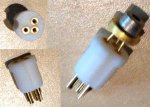Seems like diodes are very sensitive to heat and can die if not properly cooled, so I'm still wondering why we don't have female plugs on which to solder or crimp cables instead which can be connected/disconnected from the laser diode instead. Aixiz sells one but for testing.
Anyway, since soldering to the pins is the way to go, here are few questions:
1) To avoid overheating the diode, should it be put in a housing if I have one when soldering to help reduce overheating?
2) Should some flux paste be applied to the pin to make a solder joint faster?
3) Should the wire be wrapped around the pin, or just pressed to it, "hugging" from the side?
4) When adding a heatshrink, what are general practices which can be used to avoid overheating the diode from a heatgun/ lighter?
Anyway, since soldering to the pins is the way to go, here are few questions:
1) To avoid overheating the diode, should it be put in a housing if I have one when soldering to help reduce overheating?
2) Should some flux paste be applied to the pin to make a solder joint faster?
3) Should the wire be wrapped around the pin, or just pressed to it, "hugging" from the side?
4) When adding a heatshrink, what are general practices which can be used to avoid overheating the diode from a heatgun/ lighter?




